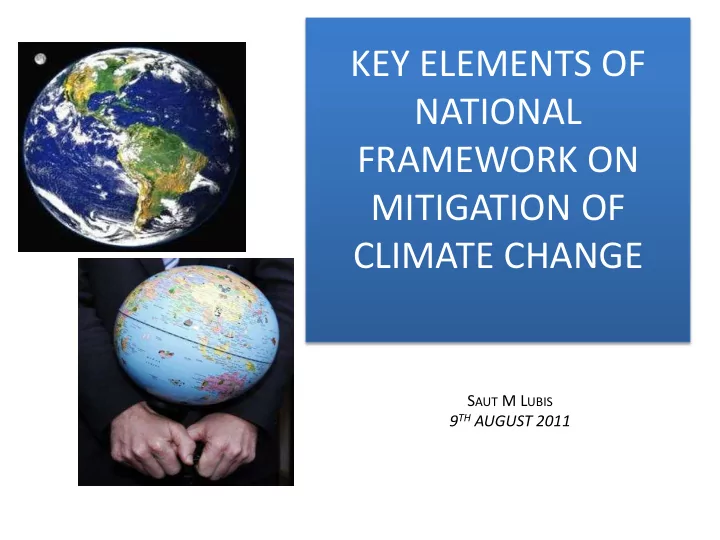

KEY ELEMENTS OF NATIONAL FRAMEWORK ON MITIGATION OF CLIMATE CHANGE S AUT M L UBIS 9 TH AUGUST 2011
(C) (C) The he Ran ange ge of of the the D Dif iffer eren ence ce be betw twee een n Emis Emissi sion ons s in in 19 1990 90 an and d Emis Emissi sion on All llowan ance ces s in in 20 2020 20/20 /2050 50 for or Variou arious s Con once centr ntration Le tion Levels els for or Ann nnex x I I And nd No Non-Ann nnex I x I Cou ountries ntries as a as a Gr Grou oup a Scenario Category Region 2020 2050 Annex I -25 % to – 40 % -80% to -95 % Substantial deviation from Substantial deviation from baseline A-450 ppm CO 2 -eq b Non-Annex I baseline in Latin America, Middle in all regions East, East Asia and Centrally- Planned Asia Annex I -10% to -30% -40% to -90% B-550 ppm CO 2 -eq Deviation from baseline in Latin Deviation from baseline in most Non-Annex I America and Middle East, East regions, especially in Latin America Asia and Middle East Annex I 0% to -25% -30% to -80% C-650 ppm CO 2 -eq Non-Annex I Baseline Deviation from baseline in Latin America and Middle East, East Asia • Source: IPCC Working Group III, Chapter 13, Box 13.7, page 776. • a) The aggregate range is based on multiple approaches to apportion emissions between regions (contraction & convergence, multistage, Triptych and intensity targets, among others). Each approach makes different assumption about the pathways, specific national efforts and other variables.Additional extreme cases – in which Annex I undertakes all reductions, or non-Annex I undertakes all reductions – are not included. The range presented here do not imply political feasibility, nor do the results reflect cost variance. • b) Only the studies aiming at stabilization at 450 ppm CO 2 -eq assume a (temporary) overshoot of about 50 ppm 10/4/2011 2 (See Den Elzen and Meinshausen, 2006)
REDUCTION IN BOX 13.7 10/4/2011 3
10/4/2011 4
DIFFERENT PERIOD OF STABILIZATION LEVELS 10/4/2011 5
10/4/2011 6
KATEGORI NAMAs • Unilateral NAMAs/Domestically Supported NAMAs (unsupported or self supporting): autonomous mitigation actions undertaken by developing country Parties on their own to achieve certain emission reduction level without international (outside) support under the UNFCCC framework • Internationally Supported NAMAs : mitigation actions by developing country Parties supported directly by developed country Parties as internationally supported mitigation actions under the UNFCCC framework • Credited NAMAs (credit generating NAMAs): mitigation actions in developing countries, which generate credits to be sold on the carbon market . 10/4/2011 7
KATEGORI NAMAs 1. UNILATERAL NAMAS/DOMESTICALLY SUPPORTED NAMAS (UNSUPPORTED OR SELF SUPPORTING): AUTONOMOUS MITIGATION ACTIONS UNDERTAKEN BY DEVELOPING COUNTRY PARTIES ON THEIR OWN TO ACHIEVE CERTAIN EMISSION REDUCTION LEVEL WITHOUT INTERNATIONAL (OUTSIDE) SUPPORT UNDER THE UNFCCC FRAMEWORK 2. INTERNATIONALLY SUPPORTED NAMAS : MITIGATION ACTIONS BY DEVELOPING COUNTRY PARTIES SUPPORTED DIRECTLY BY DEVELOPED COUNTRY PARTIES AS INTERNATIONALLY SUPPORTED MITIGATION ACTIONS UNDER THE UNFCCC FRAMEWORK 3. CREDITED NAMAS (CREDIT GENERATING NAMAS): MITIGATION ACTIONS IN DEVELOPING COUNTRIES, WHICH GENERATE CREDITS TO BE SOLD ON THE CARBON MARKET 10/4/2011 8
10/4/2011 9
10/4/2011 10
10/4/2011 11
10/4/2011 12
10/4/2011 13
BAU • The current policy, and future if exists without any climate change policy intervention and action, • Market trends and its features, • Associated uncertainties, • Evolution of supply and demand, • Cost effectiveness, and • Expected performance of the system. 10/4/2011 14
national business as usual baseline • Establishment of aggregated business as usual baseline of each sector, and • Establishment of national business as usual baseline (aggregated business as usual baseline). 10/4/2011 15
10/4/2011 16
10/4/2011 17
10/4/2011 18
10/4/2011 19
10/4/2011 20
10/4/2011 21
10/4/2011 22
10/4/2011 23
some important issues to be addressed in establishing NAMAs • Establish aggregated business as usual baseline of sectors using sector’s development plan and future evolution of activities without explicit new climate change policy intervention and action, • Propose list of potential mitigation emission reduction actions of sectors in the order according to sector’s cost effectiveness and level of implementability, • Integrate sector’s aggregated business as usual baseline to establish national business as usual baseline (aggregated), • Construct list of national aggregated mitigation emission reduction actions based on national cost effectiveness and level of implementability, • Establish NAMAs from the national aggregated mitigation emission reduction actions in meeting the national emission reduction target, and • Linkage NAMAs to the UNFCCC level. 10/4/2011 24
10/4/2011 25
10/4/2011 26
10/4/2011 27
10/4/2011 28
10/4/2011 29
Terima Kasih atas Perhatiannya
Recommend
More recommend